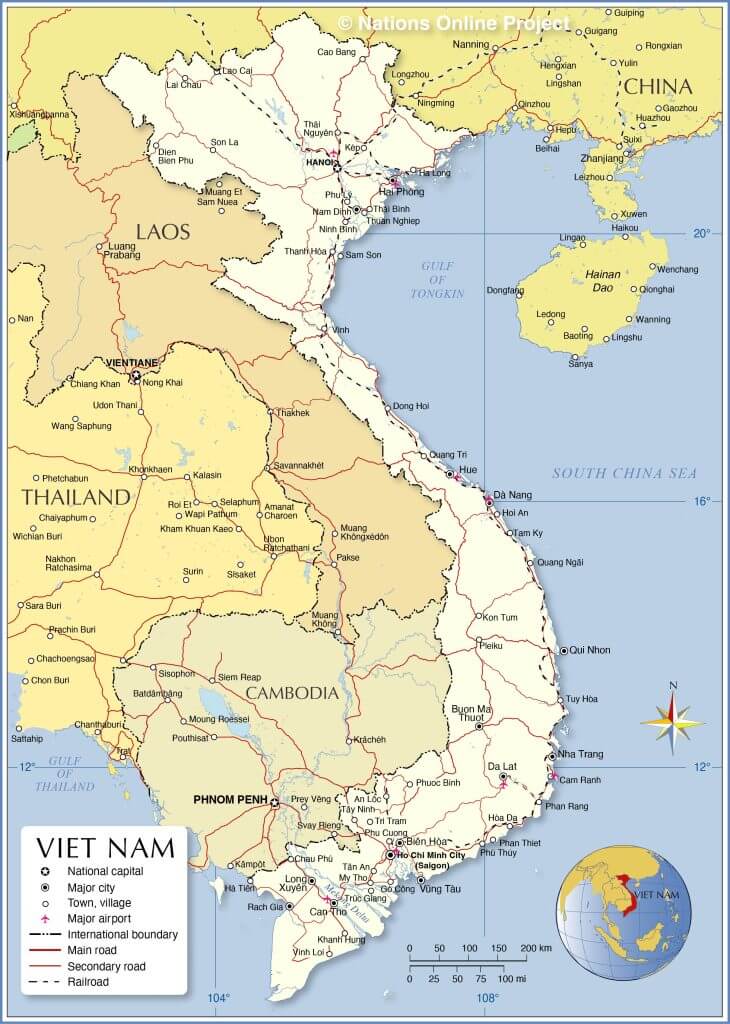#27: Touristing in Southeast AsiaHo Chi Minh City/Saigon, Hanoi
As 1992 turned to 1993, we celebrated the New Year with Vientiane friends in Ho Chi Minh City/Saigon and Hanoi. It was fascinating to experience another part of former French Indochina in transition, as the United States and Vietnam worked to restore normalcy after their war. Here are excerpts from letters to family about our adventures. (Click on photos to enlarge.)
January 6, 1993
We had anticipated that we would like Ho Chi Minh City better than Hanoi, but the reverse proved to be the case. Ho Chi Minh City is now a huge metropolis that stretches almost to the border with Cambodia. It includes the old Chinese suburb of Cholon as well as the city of Saigon. One may still speak of Saigon, meaning that section of the city, and since we spent most of our time there’s that’s the term I’ll use.
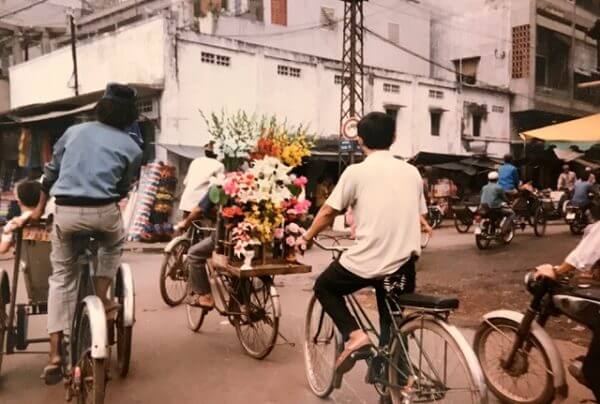 Saigon has the reputation of being further ahead than Hanoi in terms of economic and other measures. That’s true, but it’s also incredibly dirty, noisy, polluted and unpleasant. The streets have a lot of vitality. They’re filled with rows and rows of motor scooters and bicycles. There is very little public transit, so thousands of people move around on two-wheeled vehicles. And they don’t give way to pedestrians, even in striped crosswalks! Because, I think, of the myriad “motos,” the city is filthy with all the effluvia of gasoline-powered engines. The buildings are covered with grime. The streets and sidewalks are covered in oil. Even many of the people, including the children, have smears of what looks like oil on their feet and legs. The air is visibly full of exhaust fumes. My main impression of Saigon is dirty, black and polluted. The streets are also crowded with very aggressive beggars who follow after you for great distances, haranguing you and even poking you on the arm. It’s not pleasant, though your heart is moved by their plight.
Saigon has the reputation of being further ahead than Hanoi in terms of economic and other measures. That’s true, but it’s also incredibly dirty, noisy, polluted and unpleasant. The streets have a lot of vitality. They’re filled with rows and rows of motor scooters and bicycles. There is very little public transit, so thousands of people move around on two-wheeled vehicles. And they don’t give way to pedestrians, even in striped crosswalks! Because, I think, of the myriad “motos,” the city is filthy with all the effluvia of gasoline-powered engines. The buildings are covered with grime. The streets and sidewalks are covered in oil. Even many of the people, including the children, have smears of what looks like oil on their feet and legs. The air is visibly full of exhaust fumes. My main impression of Saigon is dirty, black and polluted. The streets are also crowded with very aggressive beggars who follow after you for great distances, haranguing you and even poking you on the arm. It’s not pleasant, though your heart is moved by their plight.
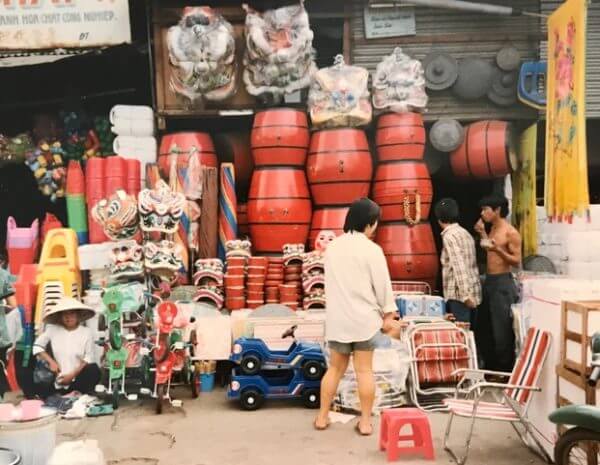 The sidewalks are jammed with vendors of very description — books and magazines, souvenirs, foods and charming toy planes made from beer and soda cans with propellers that spin. One rides everywhere in a cyclo (“see-klo”), a three-wheeled vehicle with a man pedaling on the back and the passenger in a seat upfront. [See vehicle to left of street photo in paragraph above.] The food is, on the whole, quite good, especially the noodle soup, pho (“feu” — only an approximation of the pronunciation).
The sidewalks are jammed with vendors of very description — books and magazines, souvenirs, foods and charming toy planes made from beer and soda cans with propellers that spin. One rides everywhere in a cyclo (“see-klo”), a three-wheeled vehicle with a man pedaling on the back and the passenger in a seat upfront. [See vehicle to left of street photo in paragraph above.] The food is, on the whole, quite good, especially the noodle soup, pho (“feu” — only an approximation of the pronunciation).
There are at least four hotels where foreigners who are not back-packing around the world might feel comfortable. The most famous is the Saigon Floating Hotel, an Australian concern that went broke on the Barrier Reef. So they towed it to Saigon, anchored it in the river and are doing a bang-up business. It’s the only first-class hotel, but the food’s not very good. Then there are 3-4 other hotels which are sort of mid-range. We stayed at the Rex — good food, nice rooms, efficient and clean. Our first choice had been the old Continental, newly refurbished and packed with history from both the Indochina (French) and the Vietnam (American) wars. However, it was full of tour groups so we ended up, happily, at the Rex.
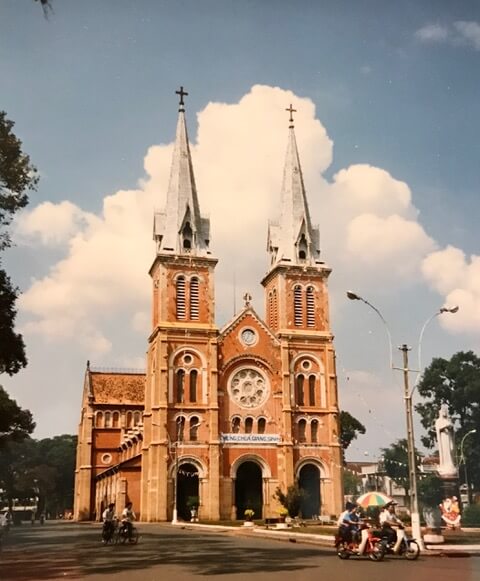 Business is supposed to be booming, and the city is said to be full of foreigners trying to make deals. We did see a lot of foreigners there, but they seemed to be mostly tourists. Of course, one dresses so casually in the climate that “tourists” might be businessmen. At any rate, there’s not much for tourists to see — the cathedral is still standing, but most of its interior seems to have been stripped of decor; the two most famous and ancient Buddhist temples are way down on their luck (although still manned by a few elderly and plucky monks); three of the four museums are basically propaganda for the current regime; and the fourth — the history museum — only has labels in Vietnamese, so it’s hard to know what you’re looking at. (I think its appropriate to have labels in the national
Business is supposed to be booming, and the city is said to be full of foreigners trying to make deals. We did see a lot of foreigners there, but they seemed to be mostly tourists. Of course, one dresses so casually in the climate that “tourists” might be businessmen. At any rate, there’s not much for tourists to see — the cathedral is still standing, but most of its interior seems to have been stripped of decor; the two most famous and ancient Buddhist temples are way down on their luck (although still manned by a few elderly and plucky monks); three of the four museums are basically propaganda for the current regime; and the fourth — the history museum — only has labels in Vietnamese, so it’s hard to know what you’re looking at. (I think its appropriate to have labels in the national 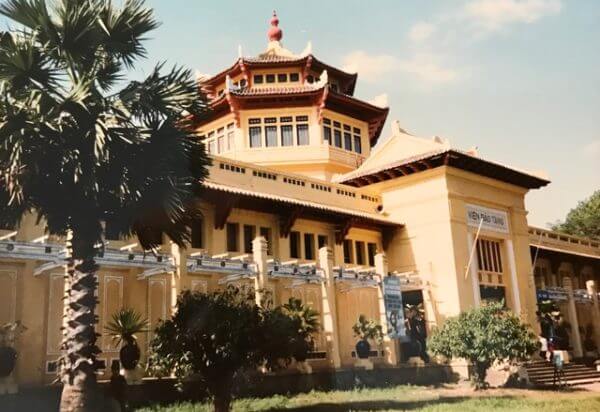 language, but museums should also offer summaries in major world languages if they want to attract tourists — witness the Japanese walking around the Smithsonian with Japanese-language tape-recordings supplied by the museum. Or other museums that have printed foreign-language handouts in each room.)
language, but museums should also offer summaries in major world languages if they want to attract tourists — witness the Japanese walking around the Smithsonian with Japanese-language tape-recordings supplied by the museum. Or other museums that have printed foreign-language handouts in each room.)
Hanoi is a far more attractive city, and there’s more to see. The former capital of French Indochina, it’s full of interesting colonial architecture on wide, tree-lined boulevards. There are museums and theaters and villas and government buildings, mostly in soft-gold with dark green shutters and white trim. The streets are not so clogged with motor scooters belching oxides, so it’s far cleaner. A lot of it was walkable from our hotel, but we also took cyclos when our legs got tired.
There seem to be many cultural opportunities in Hanoi. The History Museum was the former French School for Oriental Studies, so the collection was very interesting, although the labels were still in Vietnamese with no translation. The city is full of artists, many of them quite good, and there are art galleries everywhere. In fact, we bought two paintings — one of boats on a misty sea with mountains behind and the other a stylized view of two cats, one black, the other white. Rolled up, they arrived safe and sound. Now we must get them framed. We also got a porcelain-and-brass water pipe and a hill tribe set of silver “charms.” Both are difficult to describe, but they make interesting decorative items. [Water pipe in photo on home page.] The Vietnamese are famous for their embroidery, and we bought a tablecloth and matching napkins — not much fun to wash and iron, but they look good.
Silk is just about irresistible in Hanoi — wonderful colors and nearly weightless (Lao and Thai silks are heavier). I bought a couple of outfits and 5 meters of aubergine-color for pants with a matching over-shirt. Our friend Monique Mann had a field day buying silk clothes, but she’s an ambassador’s wife and needs a lot of that sort of thing. I tried to restrain myself to just what I thought I could truly use.
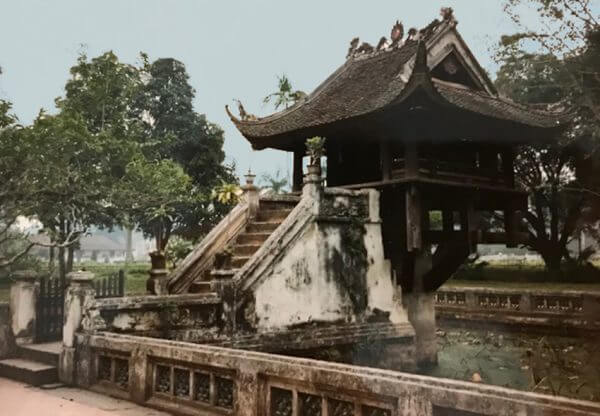 There are some very fine old pagodas in Hanoi, and I toured three of the most famous. The One Pillar Pagoda was almost 1000 years old when it was destroyed by the French after their loss at Dien Bien Phu — it seems to have been sheer wickedness that made them wreck this national treasure just before they vacated the country. It’s been rebuilt in the same form, so you can see what it was like (but of course it lacks the resonance of history).
There are some very fine old pagodas in Hanoi, and I toured three of the most famous. The One Pillar Pagoda was almost 1000 years old when it was destroyed by the French after their loss at Dien Bien Phu — it seems to have been sheer wickedness that made them wreck this national treasure just before they vacated the country. It’s been rebuilt in the same form, so you can see what it was like (but of course it lacks the resonance of history).
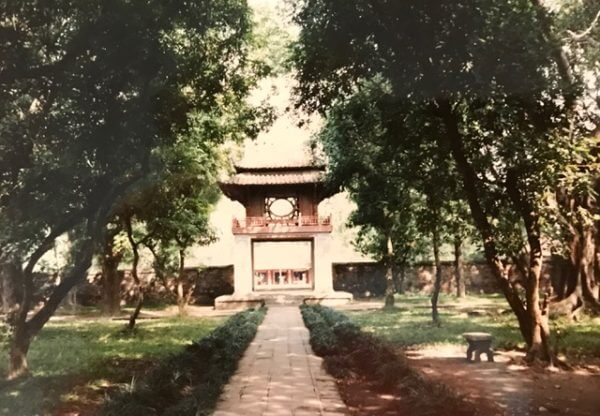 The Temple of Literature was founded in 1057 as a seat of higher learning in the Confucian tradition. It’s still standing, although much renovated, and it’s quite lovely — a series of garden-courtyards with ponds and pavilions linked by decorative gateways leading into the inner sanctum. Scores of the highest ranking mandarins were trained here to what we would term a Ph.D. level. It was a university in the Chinese tradition, whose graduates served a Vietnamese Emperor.
The Temple of Literature was founded in 1057 as a seat of higher learning in the Confucian tradition. It’s still standing, although much renovated, and it’s quite lovely — a series of garden-courtyards with ponds and pavilions linked by decorative gateways leading into the inner sanctum. Scores of the highest ranking mandarins were trained here to what we would term a Ph.D. level. It was a university in the Chinese tradition, whose graduates served a Vietnamese Emperor.
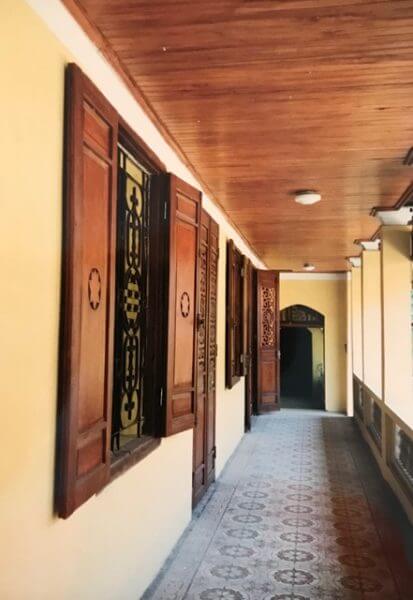 The Temple of the Ambassadors is where these representatives of other lands were lodged. It’s been so much renovated that it’s hard to perceive the original, but one still has a feeling for how it must have been.
The Temple of the Ambassadors is where these representatives of other lands were lodged. It’s been so much renovated that it’s hard to perceive the original, but one still has a feeling for how it must have been.
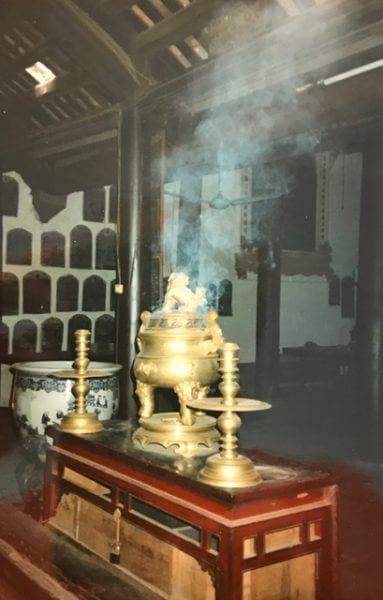 The cathedral is in much better shape, and it’s surrounded by a large compound of seminaries, nunneries, etc. At all three of these religious sites (Buddhist, Confucian and Catholic), I saw much evidence of people still worshipping — burning incense, chanting nuns, young women at prayer, young men in training. Religion is still alive and well in Vietnam.
The cathedral is in much better shape, and it’s surrounded by a large compound of seminaries, nunneries, etc. At all three of these religious sites (Buddhist, Confucian and Catholic), I saw much evidence of people still worshipping — burning incense, chanting nuns, young women at prayer, young men in training. Religion is still alive and well in Vietnam.
Russell’s series of meetings with both UN and Vietnamese officials went well. The UNDP Res Rep invited him out to the house which they had renovated and were literally moving into. They all sat among boxes for their meeting. R said the house was really impressive — an old French villa with 20-foot ceilings, fancy wooden staircase, large garden, etc. They’ve indicated that they might want him to come again for further talks at their expense. If so, I’ll go along at my expense to see and do more than we had time for.
Among other engaging features, Hanoi is full of lakes. I only saw one of them. Each has temples, restaurants, etc. It would be fun to explore them all. In addition, there’s lots to see and do outside the city, and apparently it is easier to do that than in Laos.
One hears a lot about obstructive bureaucracy in Vietnam and particularly in Hanoi, but we had little experience of it. Russell was hassled some by a Customs Officer at the airport on the way out, but that was our only personal encounter. We were traveling with the Manns and two of their friends who needed to make a change in their visa. They had quite a bit of difficulty in getting all the necessary papers (and the Vietnamese seem to require lots of paperwork for even the smallest thing). There are many horror stories, but there’s also some evidence that these things are on the decline now that Vietnam is re-entering the global economy.
I must close and get some work done. More next week.
January 13, 1993
Vietnam is a land of such contrasts. Here are three examples.
While in Ho Chi Minh City, we took a day trip to Vung Tau, formerly Cap St. Jacques, where the French would go to beat the heat of Saigon. It took about two-and-half hours to get there via rented mini-van, and the main news of the drive was a blow-out en route. Fortunately, we had a very skillful driver who stopped the car without any trouble and changed the tire while we all stood in the shade of a mango tree and ate the oranges we’d brought along.
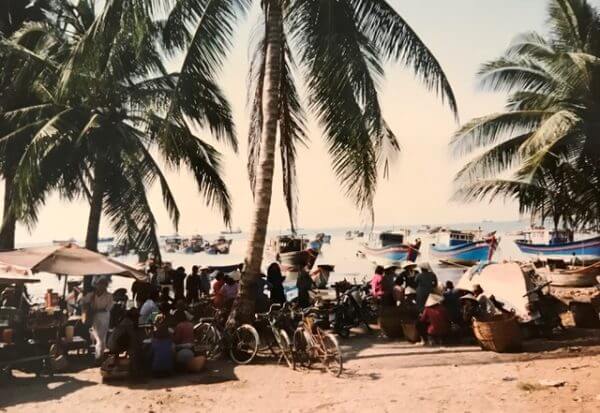 The beach itself was lovely. Half of us went swimming, while the other half sat under a thatch roof and had cold drinks. R took to the water; I took to the breezy shade. It turned out he had the better deal. The breezy shade was soon filled with beggars and boys selling postcards who wouldn’t take “no” for an answer. They kept touching Monique’s six-month-old baby, and we all ended up being quite cross and out of sorts. Our peaceful shade had turned out to be just the opposite. As soon as the swimmers returned, we firmly asked to leave, and fortunately, they understood and agreed. Almost everywhere you go in Vietnam, there are these seemingly desperate beggars. As I wrote in my previous letter, your heart goes out to them, but it’s impossible to give money to everyone, and it soon becomes a pretty terrible experience for all concerned.
The beach itself was lovely. Half of us went swimming, while the other half sat under a thatch roof and had cold drinks. R took to the water; I took to the breezy shade. It turned out he had the better deal. The breezy shade was soon filled with beggars and boys selling postcards who wouldn’t take “no” for an answer. They kept touching Monique’s six-month-old baby, and we all ended up being quite cross and out of sorts. Our peaceful shade had turned out to be just the opposite. As soon as the swimmers returned, we firmly asked to leave, and fortunately, they understood and agreed. Almost everywhere you go in Vietnam, there are these seemingly desperate beggars. As I wrote in my previous letter, your heart goes out to them, but it’s impossible to give money to everyone, and it soon becomes a pretty terrible experience for all concerned.
The rest of the day was more pleasant. We went to a beach-side hotel for lunch and strolled along the seafront. We ended up at the fish market, where they’d brought in the day’s catch — a very colorful scene. We also saw Diem’s “beach house,” a veritable palace. One can easily understand why a large segment of the population wanted to overthrow someone who wallowed in such ostentatious luxury. His palace in Saigon was even more so.
A more meaningful experience occurred later in the week when R&I went to visit one of the oldest temples in Saigon. We rode on cyclos for almost an hour out to what had originally been a temple deep in the countryside. Now the city has grown out to meet it, and the approach is through a shanty-town. The temple itself is on the shore of a small lake. Although rundown in recent years, the temple is beginning to experience renewed interest by both Vietnamese and tourists.
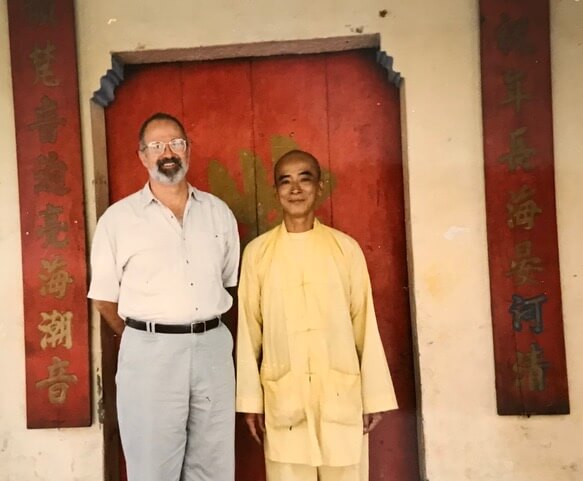 While we were walking around and absorbing the atmosphere, an older monk with the most luminous face I’ve ever seen came up to greet us, shaking hands (most unusual) and speaking in French. I was very moved to meet him. He seemed to have suffered a great deal and also to be very holy (perhaps the two go together). When we left, Russell took his hand again and said, “Courage.” It’s the same word in French and English, and R used the former pronunciation. It was the most important thing we had to give him, a sense of our awe at his life and his future. I was almost in tears.
While we were walking around and absorbing the atmosphere, an older monk with the most luminous face I’ve ever seen came up to greet us, shaking hands (most unusual) and speaking in French. I was very moved to meet him. He seemed to have suffered a great deal and also to be very holy (perhaps the two go together). When we left, Russell took his hand again and said, “Courage.” It’s the same word in French and English, and R used the former pronunciation. It was the most important thing we had to give him, a sense of our awe at his life and his future. I was almost in tears.
A last observation from our trip. We had hoped to stay at the Metropole Hotel in Hanoi. The Pullman Company of France has refurbished the hotel and turned it into a first-class establishment. Unfortunately, probably because of the international marathon being run at that time (won by an American), we were shut out. Our own hotel was perfectly adequate, but we used the Metropole for many meals and just to have a cold coffee at the end of a busy day. They’ve done a nice job with the renovation, keeping the high ceilings, massive pillars, fancy interior balconies and other structures from the old days while making it more up-to-date for foreign travelers. Right now, it’s almost the only decent place in town to eat, and they’re inundated daily, especially for their luncheon buffet of croissant sandwiches, fruit, cheese and cakes.
***
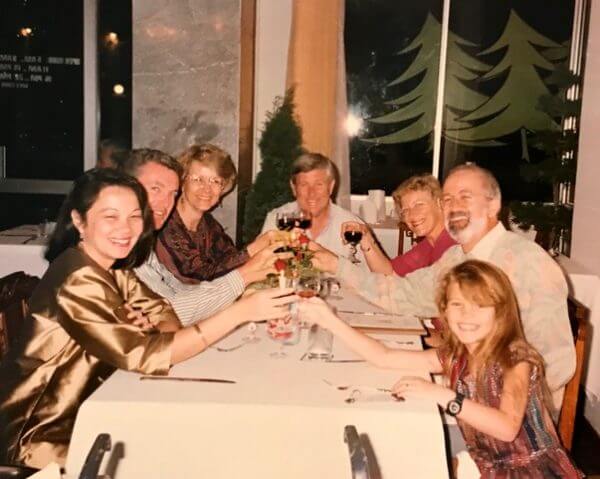 We had a happy time celebrating New Year’s Eve in Hanoi with our fellow travelers, the Mann family and their long-time friends visiting from Australia. Russell even managed to “first-foot” — an ancient family tradition from the borderland of England and Scotland, wherein the first
We had a happy time celebrating New Year’s Eve in Hanoi with our fellow travelers, the Mann family and their long-time friends visiting from Australia. Russell even managed to “first-foot” — an ancient family tradition from the borderland of England and Scotland, wherein the first 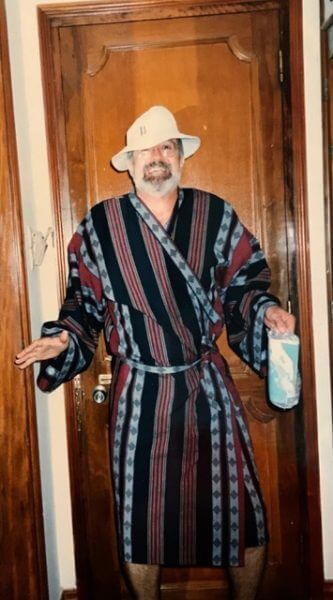 person to cross the threshold after the turn of the year must be a tall, dark man bearing the right sort of good-luck gifts. I’m not sure what the neighbors thought when he went out into the hotel hallway to re-enter our room while wearing his Lao Cotton robe, but I was thrilled to start 1993 off with a gentle bang.
person to cross the threshold after the turn of the year must be a tall, dark man bearing the right sort of good-luck gifts. I’m not sure what the neighbors thought when he went out into the hotel hallway to re-enter our room while wearing his Lao Cotton robe, but I was thrilled to start 1993 off with a gentle bang.
We took other trips while living in Laos — returning to Hong Kong; visiting Khon Kaen, a famous silk-weaving center in Thailand; resting on Penang, an island off the coast of Malaysia, before starting work in Hawaii. In the next post, we’ll move on to those two years in Honolulu, where R was a Fellow at the East-West Center, and I started the book that would become Malice on the Mekong.

COMING NEXT MONTH
Sojourn in Hawaii, 1993-1994

LET ME HEAR FROM YOU.
Please take a moment to share your thoughts.
Your comments help make the blog better, and I always answer.
* * *
If you enjoyed reading this post, I hope you’ll SUBSCRIBE by clicking on the button below. Every month, when I post a new excerpt from my life overseas, you’ll get an email with a link so you can read the next installment. Subscription is free, and I won’t share your contact information with anyone else. Your subscribing lets me know you’re reading what I write, and that means a lot.

